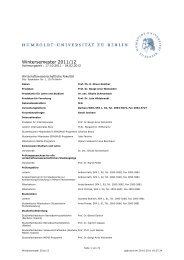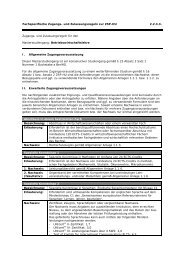Measuring the Effects of a Shock to Monetary Policy - Humboldt ...
Measuring the Effects of a Shock to Monetary Policy - Humboldt ...
Measuring the Effects of a Shock to Monetary Policy - Humboldt ...
Create successful ePaper yourself
Turn your PDF publications into a flip-book with our unique Google optimized e-Paper software.
22 Bayesian FAVARs with Agnostic Identification<br />
is static 20 and allows for some cross-correlation <strong>of</strong> <strong>the</strong> idiosyncratic components, and <strong>the</strong><br />
dynamic version <strong>of</strong> Geweke(1977) and Sargent and Sims (1977) which assumes orthog-<br />
onalized idiosyncratic components. Their concept is mostly known as <strong>the</strong> generalized<br />
dynamic fac<strong>to</strong>r model and in <strong>the</strong> current literature also known as <strong>the</strong> dynamic principal<br />
component analysis (DPCA). Here <strong>the</strong>y do a principal component analysis <strong>of</strong> <strong>the</strong> first<br />
Q eigenvalues and eigenvec<strong>to</strong>rs which are calculated from <strong>the</strong> variance-covariance matrix<br />
(VCV) <strong>of</strong> <strong>the</strong> data set. The GDFM or <strong>the</strong> DPCA can be summarized as a concept that<br />
has a similar representation as <strong>the</strong> static fac<strong>to</strong>r model but with a dynamic setting with<br />
respect <strong>to</strong> <strong>the</strong> fac<strong>to</strong>r loadings.<br />
4.3.2 Two-Step Estimation<br />
This approach is analogous <strong>to</strong> <strong>the</strong> estimation procedure used in S<strong>to</strong>ck and Watson [2002],<br />
where <strong>the</strong>y used DFMs <strong>to</strong> forecast inflation. In order <strong>to</strong> uncover <strong>the</strong> space spanned by <strong>the</strong><br />
common components Ct = (F ′<br />
t, Y ′<br />
t ) ′ as a first step <strong>the</strong> first [K+M] principal components<br />
(henceforth PC) <strong>of</strong> Xt are estimated. Here <strong>the</strong> attentive reader should note that this<br />
first step does not exploit <strong>the</strong> fact that Yt is observed 21 Fur<strong>the</strong>rmore <strong>the</strong> number <strong>of</strong> <strong>the</strong><br />
informative variables N has <strong>to</strong> be large and <strong>the</strong> number <strong>of</strong> <strong>the</strong> PCs have <strong>to</strong> be at least as<br />
large as <strong>the</strong> true number <strong>of</strong> <strong>the</strong> fac<strong>to</strong>rs for <strong>the</strong> PCs <strong>to</strong> recover <strong>the</strong> space spanned Ft and<br />
Yt consistently. As a fur<strong>the</strong>r disadvantage one should state that <strong>the</strong> two-step approach<br />
implies <strong>the</strong> presence <strong>of</strong> ”generated regressors” in <strong>the</strong> second step 22 . Ft is obtained as<br />
<strong>the</strong> part <strong>of</strong> <strong>the</strong> space covered by Ct that is not covered by Yt. The advantage <strong>of</strong> this<br />
approach is that it is easy <strong>to</strong> implement and computationally simple as opposed <strong>to</strong> <strong>the</strong><br />
computer intensive burdensome Gibbs-Sampling approach. S<strong>to</strong>ck and Watson state that<br />
it also imposes few distributional assumptions and allows for some degree correlation in<br />
20 In this context, <strong>the</strong> static version <strong>of</strong> <strong>the</strong> fac<strong>to</strong>r model means that <strong>the</strong> common shocks only affect <strong>the</strong><br />
series contemporaneously.<br />
21 For our baseline model this means that <strong>the</strong> fed’s policy action is not taken in<strong>to</strong> account contempo-<br />
raneously.<br />
22 For more details please refer <strong>to</strong> BBE [2005].




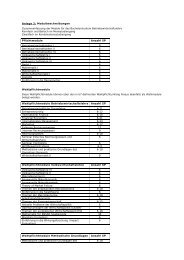


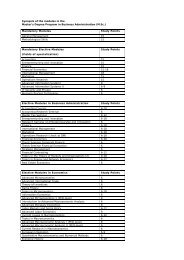
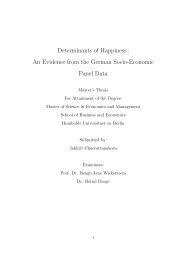
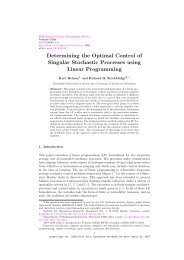
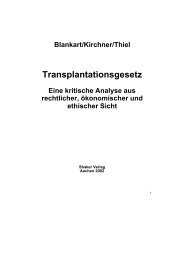


![[Text eingeben] [Text eingeben] Lebenslauf Anna-Maria Schneider](https://img.yumpu.com/16300391/1/184x260/text-eingeben-text-eingeben-lebenslauf-anna-maria-schneider.jpg?quality=85)

